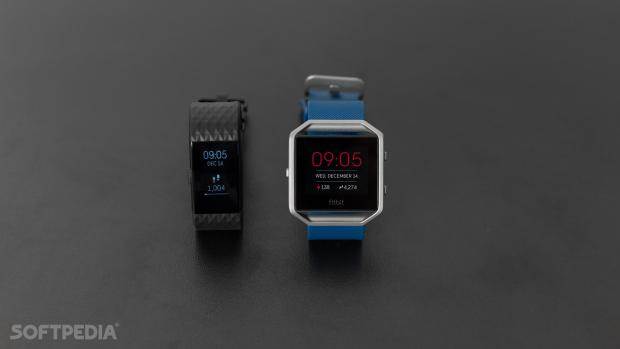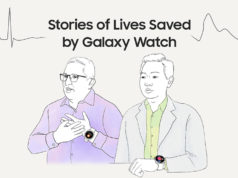Fitbit continues to be number one in terms of wearable sales, as the company sold a total of 5.3 million units in the third quarter of 2016 for a market share of 23 percent, according to IDC data.
Although Apple has improved a lot thanks to the Apple Watch, the Cupertino-based company is only fourth in Q3 2016 charts, with 1.1 million sold units (4.9 percent market share), while Xiaomi and Garmin take the second and the third place, respectively. But in the end, it’s very clear that Fitbit is by far the leading choice for those looking for new wearables.
Earlier this year, the company revamped its product portfolio with new models, including an updated Charge version that it calls… Charge 2.
Built from the very beginning to be super-comfortable to wear, the Charge 2 incorporates Fitbit’s latest technologies that are also available on the more-expensive Blaze, including PurePulse heart rate monitoring, reminders to move, and SmartTrack for auto exercise recognition.
The charge was Fitbit’s best-selling tracker, so the second generation is expected to continue the success of the original model, and even surpass it thanks to all these upgrades.
But can it really do that? Is the Charge 2 worth the $150 (€160) price? Does it have what it takes to be used as a full smartwatch replacement? These are all questions that we’re going to answer in the next chapters.

HARDWARE
First and foremost, the Charge 2 comes with an OLED display that provides you with information such as the current time, steps, heart rate, and calories burned. It can also be used for starting a new workout, and you can navigate either by touch or using the only side button.
The screen has no colors, and this is particularly important for battery life because Fitbit paid particular attention to how long you can use the tracker. It features a lithium-polymer battery which Fitbit says that can last up to 5 days, but this obviously depends on a number of workouts, such as how often you exercise and how you use the device.
The company, however, recommends “charging the device every few days to ensure that you’re always tracking,” so it’s better to charge it every 4 days. As for real-life performance, the 5-day estimate is not at all inaccurate, and during our test, the Charge 2 provided between 3 and 5 days of battery life, again depending on how it was used.
The lack of a GPS sensor helps a lot because, on most wearables, GPS is the main battery hog. And thanks to the display and the battery optimizations implemented by Fitbit, the 5-day battery life is not at all far-fetched.
The Charge 2 also comes with an optical heart rate tracker which powers what Fitbit calls “PurePUlse Heart Rate,” a catchy name for a heart activity monitoring with a few extras. There’s also an altimeter for counting floors, a vibration motor, and a 3-asix accelerometer.
If you’re looking for features like GPS, speakers, microphones, or barometers, they’re not there because, at this point, Fitbit just wants to go with the essentials and make sure that these are working correctly.

The device comes with interchangeable bands, and you can choose from a large collection, including bands made from metal and from leather. The default one is made from elastomer, similar to what you can find right now on the majority of smartwatches, but it’s really comfortable to wear all the time.
The design of the tracker also contributes to this, and it follows the shape of the wrist in a more natural way than the Microsoft Band 2, for example. There’s barely any pressure on your wrist, and the only thing that’s in contact with your skin all the time is the heart rate sensor. The band comes with a surgical-grade stainless steel buckle that keeps the tracker in place all the time, as long as you adjust it correctly.
The Fitbit Charge 2 uses Bluetooth LE to connect to your phone, and it can work with iOS, Android, and even Windows smartphones thanks to the dedicated app available on all these platforms.
FEATURES
If you’re planning on buying the Charge 2 to use it as a smartwatch, you shouldn’t do it. Although it does come with some features that you typically find on smartwatches, the Charge 2 is first and foremost an activity tracker that’s supposed to monitor your workout sessions.
It can alert on phone notifications, but support is very basic. For example, the Charge 2 vibrates on new calls, text messages, or calendar events, but it won’t show emails, WhatsApp or Facebook messages. And it doesn’t let you interact with calls or messages in any way, so its only purpose is to alert you and then it’s up to you yo take further action on the phone.
The Charge 2 also supports several clock faces, but there’s nothing to be super-excited about because most options are pretty basic. You can configure them from the companion Fitbit app on the phone, where you can also find alarms, should you want to use the tracker to wake you up in the morning.
If in terms of smartwatch capabilities the Charge 2 does not excel, the activity tracking section is the one that Fitbit has been specifically focused on.

First and foremost, the heart rate tracker, which Fitbit calls PurePulse Heart Rate, offers continuous and automatic heart rate monitoring providing statistics and analysis which the company says should help track health and manage stress.
Truth be told, the tracker does offer heart rate zones support, which helps you better adjust workouts for cardio or fat burning (a feature that’s also available on other devices like the Microsoft Band 2 and Samsung Gear Fit 2), but it also comes with readings that could help improve health and fitness. The Fitbit app offers plenty of information on your heart rate statistics, as well as tips to improve cardio fitness and find the best exercises for each individual.
As far as exercises are concerned, the Fitbit Charge 2 comes with SmartTrack, a feature that enables auto exercise recognition for a wide array of activities, including biking and hiking. Monitoring starts automatically, and you can always see essential stats on your display while you work out.
“Super comfortable all the time.”
One important thing is that the Charge 2 does not come with a GPS module, but it offers what Fitbit calls “Connected GPS.” In other words, there’s no GPS in there, but the tracker can connect to your phone’s GPS module when a Bluetooth connection is available to provide mapping data and more accurate distance monitoring.
This is a double-edged sword because while you can’t use the tracker without a phone to map your exercise, you actually get longer battery life, which for so many people is essential. The lack of GPS shouldn’t be a problem if you plan on doing activities like running or biking, as the phone can always be around or in the pocket.
The tracker also provides reminders to move to stay in shape. The Charge 2 is configured to “convince” you to take 250 steps every hour, but the Fitbit companion app lets you disable these reminders.
Auto activity tracking seems to be working quite accurately, and during our tests, the Charge 2 correctly tracked my running sessions every time without me manually starting a new workout. But as a general recommendation, it’s better to do this every time because this way you won’t lose any stats, as auto recognition might fail to kick in from the very beginning and it could miss a few minutes of your workout session.

Sleep tracking is also one of the features that you could find very helpful, but again, we’ve found this to be slightly inaccurate. Basically, sleep monitoring begins when laying down in bed and not when you actually fall asleep. So for example, if every night you’re watching a couple of episodes of Homeland before you go to bed, there’s a good chance that sitting relaxed on the couch and watching a movie is actually tracked as sleeping.
The Fitbit app also lets you configure your sleep goals, and you can configure bedtime and wakeup time, as well as bedtime reminders to make sure you stick with your schedule.
Another helpful feature is guided breathing sessions, which are similar to the Breathe app that’s available on Apple Watch starting with watchOS 3 update. The tracker guides you to breathe correctly and relax using instructions that are adapted to your real-time heart activity. You can choose between two-minute or five-minute sessions, and you can stop at any moment.
“Frequent firmware updates.”
A firmware update that was released in mid-December brought additional features on the Charge 2, including a vibration that guides you throughout the breathing session. Previously, the tracker was displaying visual guidance only, so with this update, the Charge 2’s guided breathing feature works similarly to the one on the Apple Watch.
Additionally, the same firmware update also brings a new face, but there’s nothing to be super excited about because you only get basic information and nothing more. You can also toggle the tracker on silent by muting notifications straight from the device (and not using the phone, and see battery level on the screen (previously, this information was exclusively available on the device itself).
THE BOTTOM LINE
Let’s start by making this simple: the Charge 2 is one of the best trackers we’ve tried so far. The best smartwatch? Not so much.
Fitbit has never been into smartwatches, and the Charge 2 is the living proof, as it perfectly puts the company’s focus on activity tracking in the spotlight.
There’s no doubt that the Charge 2 was designed to tackle buyers who are trying to lose weight, stay in shape, or simply adopt a more active lifestyle, but since the times are changing, Fitbit had no other option than to add a few smartwatch capabilities as well.
Notification support is very limited, but it’s only…







